Analyzing Maternal Health in the US: A Case Study of Gender Inequity
VerifiedAdded on 2023/04/11
|11
|2518
|202
Case Study
AI Summary
This case study examines the state of gender inequity and its impact on maternal health, morbidity, and mortality in the United States. It highlights the role of social determinants of health, including race/ethnicity, socioeconomic status, and geographical location, in creating barriers to improved maternal health outcomes. The study analyzes strategies used by healthcare professionals to address these determinants, linking them to UN Sustainability Goals 3 (Good Health and Well-being) and 5 (Gender Equality). It recommends reducing maternal healthcare costs and empowering women to enhance maternal health, emphasizing the need for targeted interventions and policy changes to address gender inequity and improve healthcare access for vulnerable populations. Desklib provides access to similar case studies and resources for students.
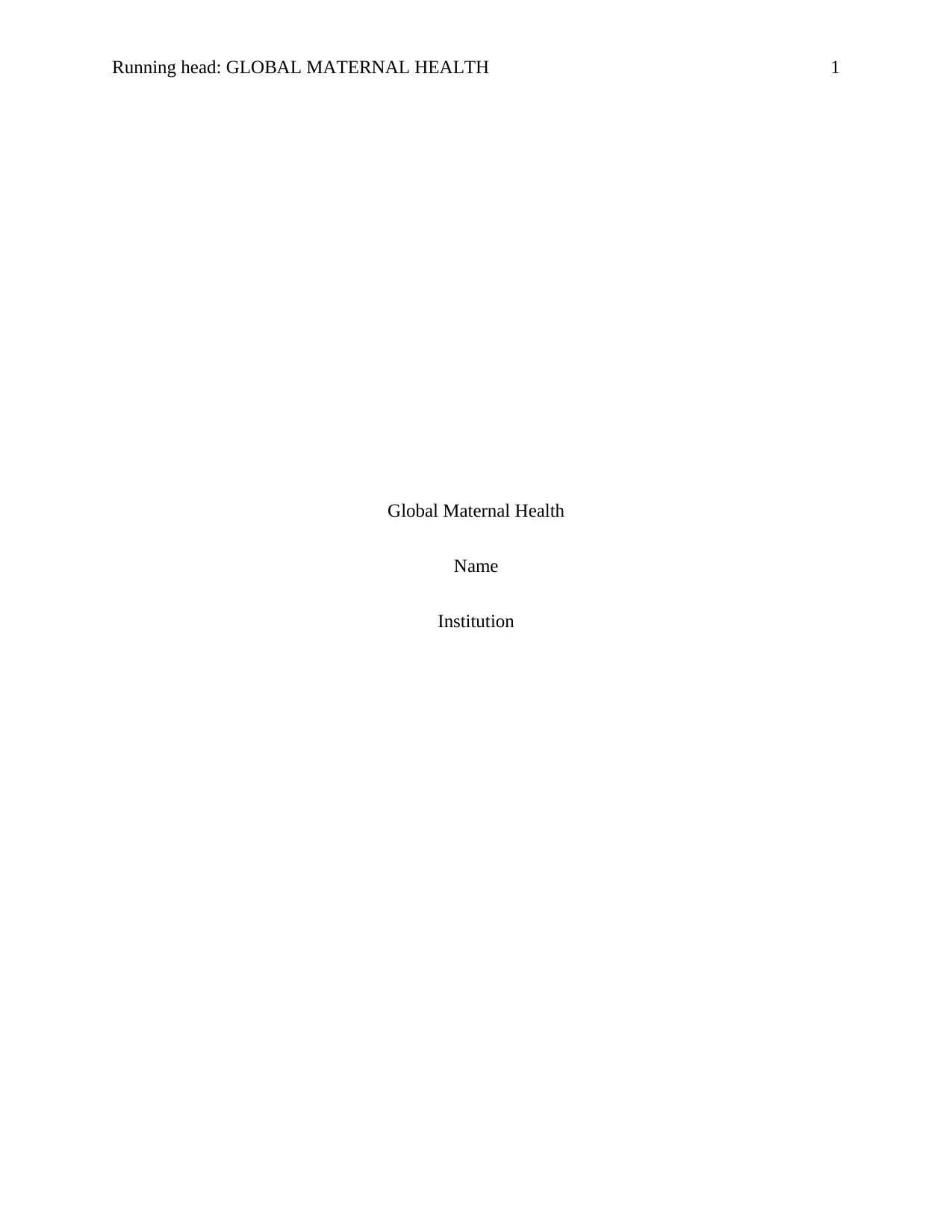
Running head: GLOBAL MATERNAL HEALTH 1
Global Maternal Health
Name
Institution
Global Maternal Health
Name
Institution
Paraphrase This Document
Need a fresh take? Get an instant paraphrase of this document with our AI Paraphraser
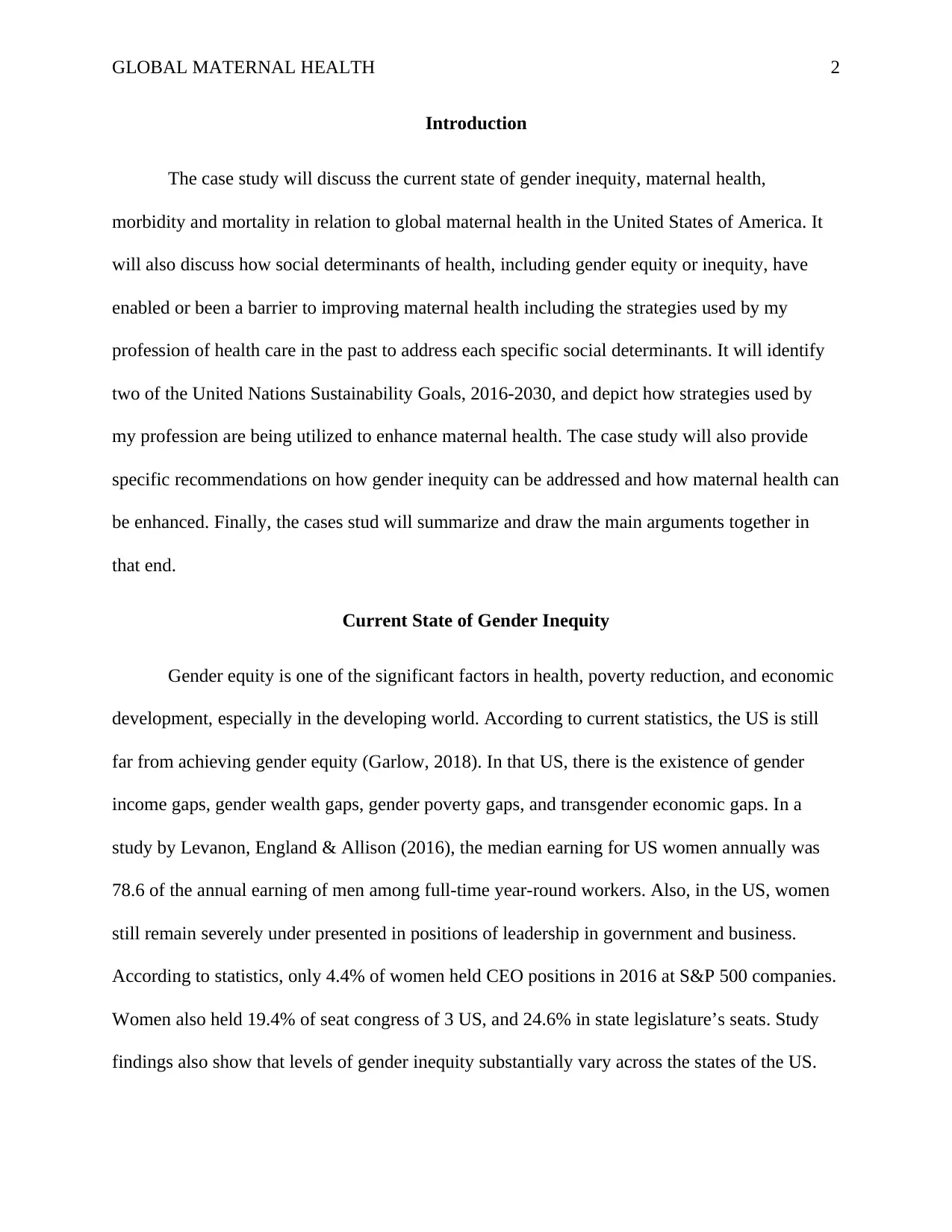
GLOBAL MATERNAL HEALTH 2
Introduction
The case study will discuss the current state of gender inequity, maternal health,
morbidity and mortality in relation to global maternal health in the United States of America. It
will also discuss how social determinants of health, including gender equity or inequity, have
enabled or been a barrier to improving maternal health including the strategies used by my
profession of health care in the past to address each specific social determinants. It will identify
two of the United Nations Sustainability Goals, 2016-2030, and depict how strategies used by
my profession are being utilized to enhance maternal health. The case study will also provide
specific recommendations on how gender inequity can be addressed and how maternal health can
be enhanced. Finally, the cases stud will summarize and draw the main arguments together in
that end.
Current State of Gender Inequity
Gender equity is one of the significant factors in health, poverty reduction, and economic
development, especially in the developing world. According to current statistics, the US is still
far from achieving gender equity (Garlow, 2018). In that US, there is the existence of gender
income gaps, gender wealth gaps, gender poverty gaps, and transgender economic gaps. In a
study by Levanon, England & Allison (2016), the median earning for US women annually was
78.6 of the annual earning of men among full-time year-round workers. Also, in the US, women
still remain severely under presented in positions of leadership in government and business.
According to statistics, only 4.4% of women held CEO positions in 2016 at S&P 500 companies.
Women also held 19.4% of seat congress of 3 US, and 24.6% in state legislature’s seats. Study
findings also show that levels of gender inequity substantially vary across the states of the US.
Introduction
The case study will discuss the current state of gender inequity, maternal health,
morbidity and mortality in relation to global maternal health in the United States of America. It
will also discuss how social determinants of health, including gender equity or inequity, have
enabled or been a barrier to improving maternal health including the strategies used by my
profession of health care in the past to address each specific social determinants. It will identify
two of the United Nations Sustainability Goals, 2016-2030, and depict how strategies used by
my profession are being utilized to enhance maternal health. The case study will also provide
specific recommendations on how gender inequity can be addressed and how maternal health can
be enhanced. Finally, the cases stud will summarize and draw the main arguments together in
that end.
Current State of Gender Inequity
Gender equity is one of the significant factors in health, poverty reduction, and economic
development, especially in the developing world. According to current statistics, the US is still
far from achieving gender equity (Garlow, 2018). In that US, there is the existence of gender
income gaps, gender wealth gaps, gender poverty gaps, and transgender economic gaps. In a
study by Levanon, England & Allison (2016), the median earning for US women annually was
78.6 of the annual earning of men among full-time year-round workers. Also, in the US, women
still remain severely under presented in positions of leadership in government and business.
According to statistics, only 4.4% of women held CEO positions in 2016 at S&P 500 companies.
Women also held 19.4% of seat congress of 3 US, and 24.6% in state legislature’s seats. Study
findings also show that levels of gender inequity substantially vary across the states of the US.
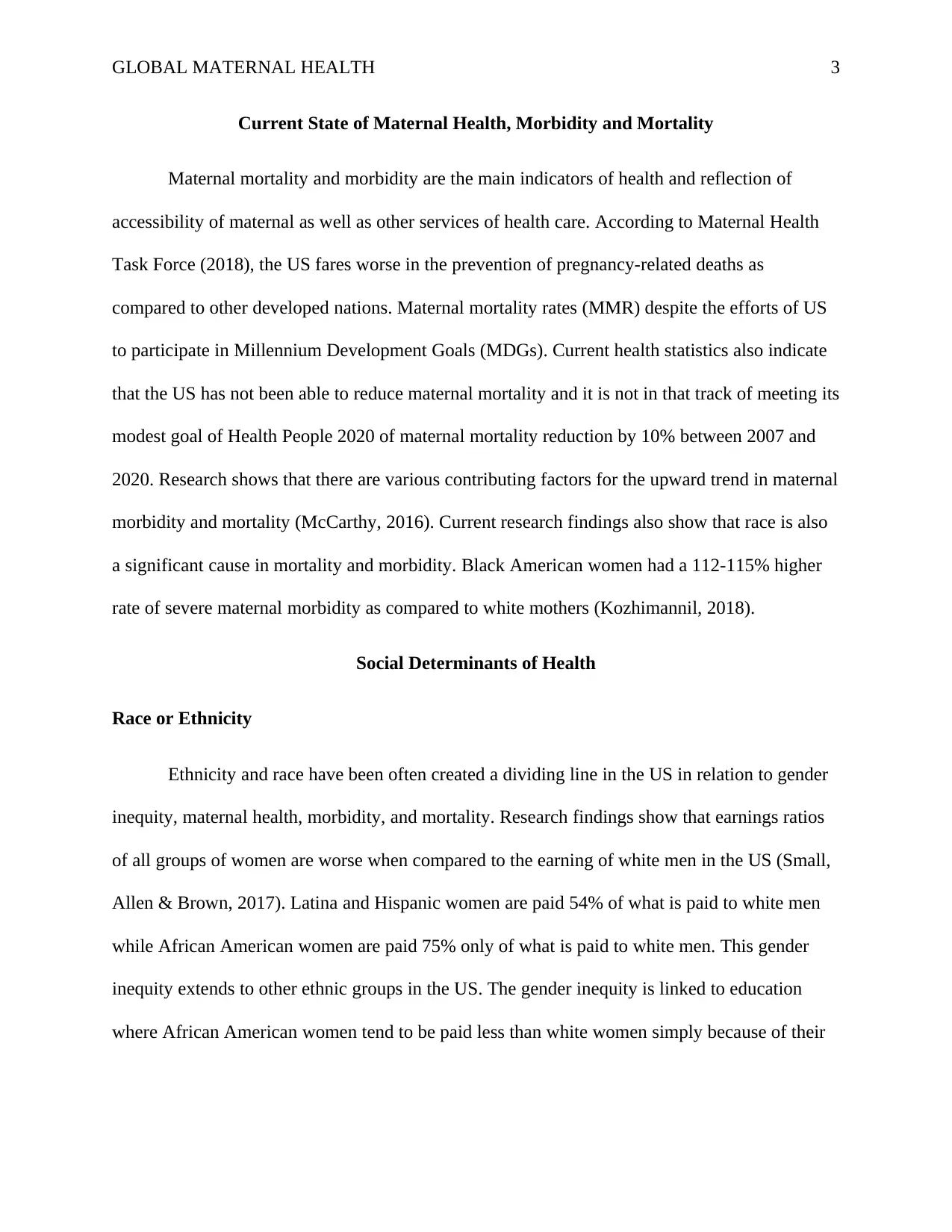
GLOBAL MATERNAL HEALTH 3
Current State of Maternal Health, Morbidity and Mortality
Maternal mortality and morbidity are the main indicators of health and reflection of
accessibility of maternal as well as other services of health care. According to Maternal Health
Task Force (2018), the US fares worse in the prevention of pregnancy-related deaths as
compared to other developed nations. Maternal mortality rates (MMR) despite the efforts of US
to participate in Millennium Development Goals (MDGs). Current health statistics also indicate
that the US has not been able to reduce maternal mortality and it is not in that track of meeting its
modest goal of Health People 2020 of maternal mortality reduction by 10% between 2007 and
2020. Research shows that there are various contributing factors for the upward trend in maternal
morbidity and mortality (McCarthy, 2016). Current research findings also show that race is also
a significant cause in mortality and morbidity. Black American women had a 112-115% higher
rate of severe maternal morbidity as compared to white mothers (Kozhimannil, 2018).
Social Determinants of Health
Race or Ethnicity
Ethnicity and race have been often created a dividing line in the US in relation to gender
inequity, maternal health, morbidity, and mortality. Research findings show that earnings ratios
of all groups of women are worse when compared to the earning of white men in the US (Small,
Allen & Brown, 2017). Latina and Hispanic women are paid 54% of what is paid to white men
while African American women are paid 75% only of what is paid to white men. This gender
inequity extends to other ethnic groups in the US. The gender inequity is linked to education
where African American women tend to be paid less than white women simply because of their
Current State of Maternal Health, Morbidity and Mortality
Maternal mortality and morbidity are the main indicators of health and reflection of
accessibility of maternal as well as other services of health care. According to Maternal Health
Task Force (2018), the US fares worse in the prevention of pregnancy-related deaths as
compared to other developed nations. Maternal mortality rates (MMR) despite the efforts of US
to participate in Millennium Development Goals (MDGs). Current health statistics also indicate
that the US has not been able to reduce maternal mortality and it is not in that track of meeting its
modest goal of Health People 2020 of maternal mortality reduction by 10% between 2007 and
2020. Research shows that there are various contributing factors for the upward trend in maternal
morbidity and mortality (McCarthy, 2016). Current research findings also show that race is also
a significant cause in mortality and morbidity. Black American women had a 112-115% higher
rate of severe maternal morbidity as compared to white mothers (Kozhimannil, 2018).
Social Determinants of Health
Race or Ethnicity
Ethnicity and race have been often created a dividing line in the US in relation to gender
inequity, maternal health, morbidity, and mortality. Research findings show that earnings ratios
of all groups of women are worse when compared to the earning of white men in the US (Small,
Allen & Brown, 2017). Latina and Hispanic women are paid 54% of what is paid to white men
while African American women are paid 75% only of what is paid to white men. This gender
inequity extends to other ethnic groups in the US. The gender inequity is linked to education
where African American women tend to be paid less than white women simply because of their
⊘ This is a preview!⊘
Do you want full access?
Subscribe today to unlock all pages.

Trusted by 1+ million students worldwide
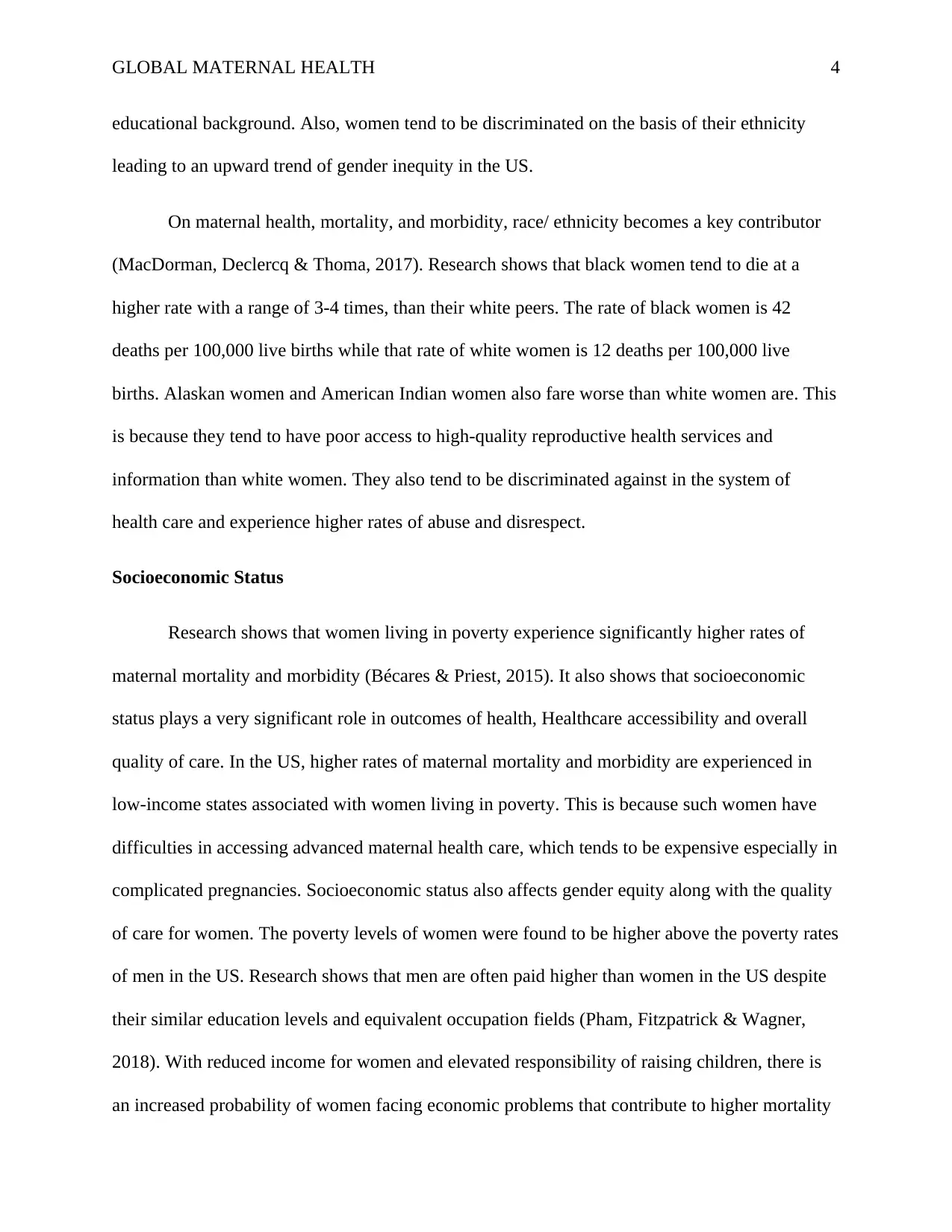
GLOBAL MATERNAL HEALTH 4
educational background. Also, women tend to be discriminated on the basis of their ethnicity
leading to an upward trend of gender inequity in the US.
On maternal health, mortality, and morbidity, race/ ethnicity becomes a key contributor
(MacDorman, Declercq & Thoma, 2017). Research shows that black women tend to die at a
higher rate with a range of 3-4 times, than their white peers. The rate of black women is 42
deaths per 100,000 live births while that rate of white women is 12 deaths per 100,000 live
births. Alaskan women and American Indian women also fare worse than white women are. This
is because they tend to have poor access to high-quality reproductive health services and
information than white women. They also tend to be discriminated against in the system of
health care and experience higher rates of abuse and disrespect.
Socioeconomic Status
Research shows that women living in poverty experience significantly higher rates of
maternal mortality and morbidity (Bécares & Priest, 2015). It also shows that socioeconomic
status plays a very significant role in outcomes of health, Healthcare accessibility and overall
quality of care. In the US, higher rates of maternal mortality and morbidity are experienced in
low-income states associated with women living in poverty. This is because such women have
difficulties in accessing advanced maternal health care, which tends to be expensive especially in
complicated pregnancies. Socioeconomic status also affects gender equity along with the quality
of care for women. The poverty levels of women were found to be higher above the poverty rates
of men in the US. Research shows that men are often paid higher than women in the US despite
their similar education levels and equivalent occupation fields (Pham, Fitzpatrick & Wagner,
2018). With reduced income for women and elevated responsibility of raising children, there is
an increased probability of women facing economic problems that contribute to higher mortality
educational background. Also, women tend to be discriminated on the basis of their ethnicity
leading to an upward trend of gender inequity in the US.
On maternal health, mortality, and morbidity, race/ ethnicity becomes a key contributor
(MacDorman, Declercq & Thoma, 2017). Research shows that black women tend to die at a
higher rate with a range of 3-4 times, than their white peers. The rate of black women is 42
deaths per 100,000 live births while that rate of white women is 12 deaths per 100,000 live
births. Alaskan women and American Indian women also fare worse than white women are. This
is because they tend to have poor access to high-quality reproductive health services and
information than white women. They also tend to be discriminated against in the system of
health care and experience higher rates of abuse and disrespect.
Socioeconomic Status
Research shows that women living in poverty experience significantly higher rates of
maternal mortality and morbidity (Bécares & Priest, 2015). It also shows that socioeconomic
status plays a very significant role in outcomes of health, Healthcare accessibility and overall
quality of care. In the US, higher rates of maternal mortality and morbidity are experienced in
low-income states associated with women living in poverty. This is because such women have
difficulties in accessing advanced maternal health care, which tends to be expensive especially in
complicated pregnancies. Socioeconomic status also affects gender equity along with the quality
of care for women. The poverty levels of women were found to be higher above the poverty rates
of men in the US. Research shows that men are often paid higher than women in the US despite
their similar education levels and equivalent occupation fields (Pham, Fitzpatrick & Wagner,
2018). With reduced income for women and elevated responsibility of raising children, there is
an increased probability of women facing economic problems that contribute to higher mortality
Paraphrase This Document
Need a fresh take? Get an instant paraphrase of this document with our AI Paraphraser
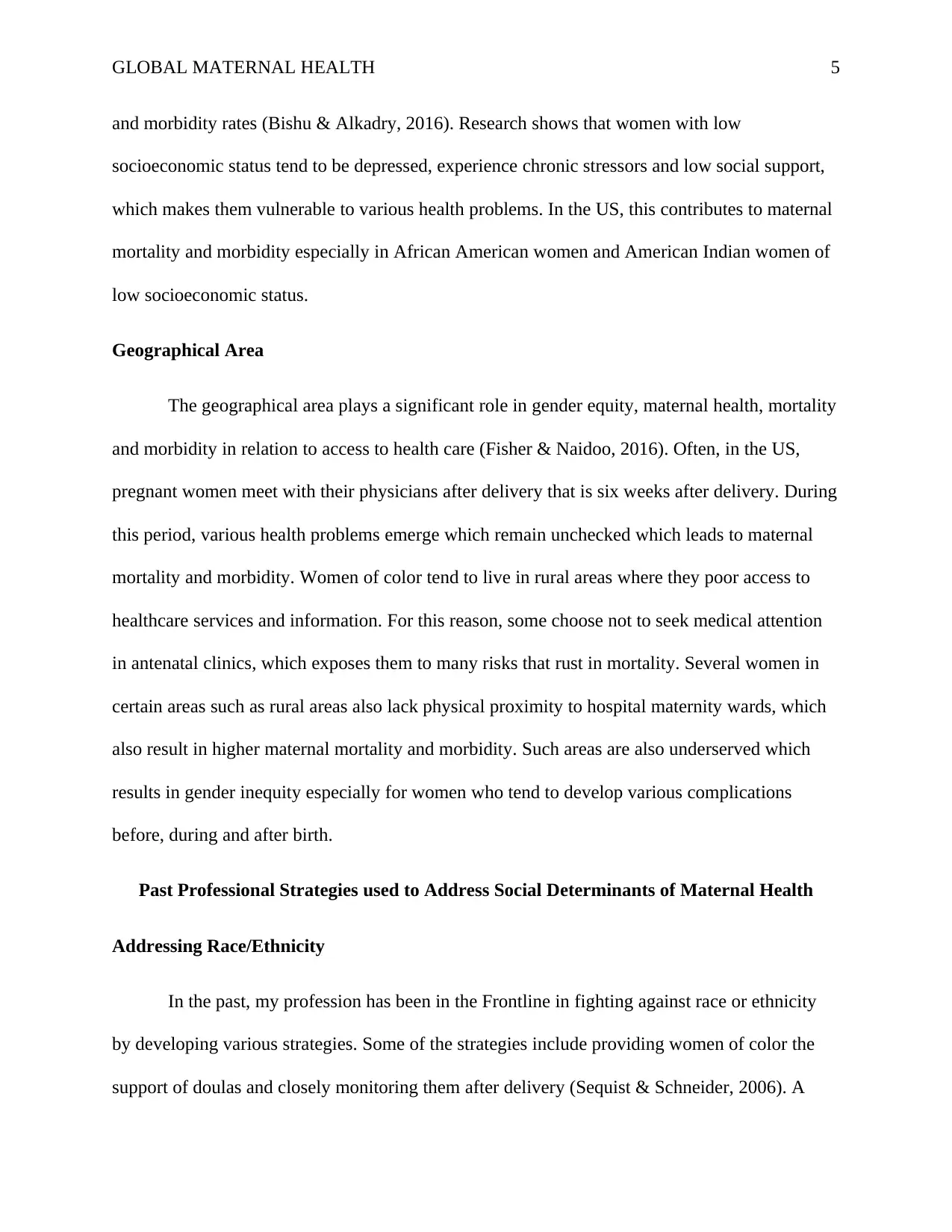
GLOBAL MATERNAL HEALTH 5
and morbidity rates (Bishu & Alkadry, 2016). Research shows that women with low
socioeconomic status tend to be depressed, experience chronic stressors and low social support,
which makes them vulnerable to various health problems. In the US, this contributes to maternal
mortality and morbidity especially in African American women and American Indian women of
low socioeconomic status.
Geographical Area
The geographical area plays a significant role in gender equity, maternal health, mortality
and morbidity in relation to access to health care (Fisher & Naidoo, 2016). Often, in the US,
pregnant women meet with their physicians after delivery that is six weeks after delivery. During
this period, various health problems emerge which remain unchecked which leads to maternal
mortality and morbidity. Women of color tend to live in rural areas where they poor access to
healthcare services and information. For this reason, some choose not to seek medical attention
in antenatal clinics, which exposes them to many risks that rust in mortality. Several women in
certain areas such as rural areas also lack physical proximity to hospital maternity wards, which
also result in higher maternal mortality and morbidity. Such areas are also underserved which
results in gender inequity especially for women who tend to develop various complications
before, during and after birth.
Past Professional Strategies used to Address Social Determinants of Maternal Health
Addressing Race/Ethnicity
In the past, my profession has been in the Frontline in fighting against race or ethnicity
by developing various strategies. Some of the strategies include providing women of color the
support of doulas and closely monitoring them after delivery (Sequist & Schneider, 2006). A
and morbidity rates (Bishu & Alkadry, 2016). Research shows that women with low
socioeconomic status tend to be depressed, experience chronic stressors and low social support,
which makes them vulnerable to various health problems. In the US, this contributes to maternal
mortality and morbidity especially in African American women and American Indian women of
low socioeconomic status.
Geographical Area
The geographical area plays a significant role in gender equity, maternal health, mortality
and morbidity in relation to access to health care (Fisher & Naidoo, 2016). Often, in the US,
pregnant women meet with their physicians after delivery that is six weeks after delivery. During
this period, various health problems emerge which remain unchecked which leads to maternal
mortality and morbidity. Women of color tend to live in rural areas where they poor access to
healthcare services and information. For this reason, some choose not to seek medical attention
in antenatal clinics, which exposes them to many risks that rust in mortality. Several women in
certain areas such as rural areas also lack physical proximity to hospital maternity wards, which
also result in higher maternal mortality and morbidity. Such areas are also underserved which
results in gender inequity especially for women who tend to develop various complications
before, during and after birth.
Past Professional Strategies used to Address Social Determinants of Maternal Health
Addressing Race/Ethnicity
In the past, my profession has been in the Frontline in fighting against race or ethnicity
by developing various strategies. Some of the strategies include providing women of color the
support of doulas and closely monitoring them after delivery (Sequist & Schneider, 2006). A
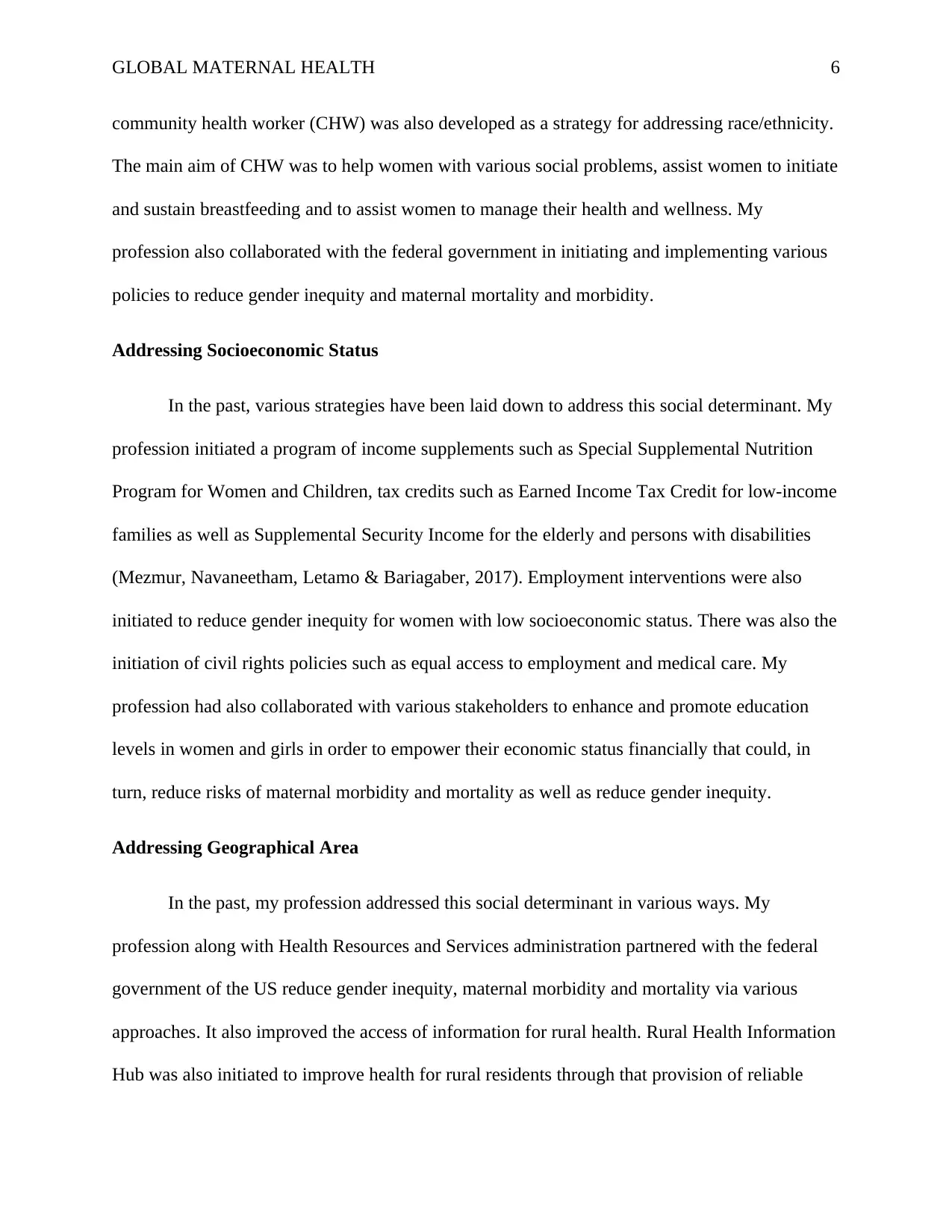
GLOBAL MATERNAL HEALTH 6
community health worker (CHW) was also developed as a strategy for addressing race/ethnicity.
The main aim of CHW was to help women with various social problems, assist women to initiate
and sustain breastfeeding and to assist women to manage their health and wellness. My
profession also collaborated with the federal government in initiating and implementing various
policies to reduce gender inequity and maternal mortality and morbidity.
Addressing Socioeconomic Status
In the past, various strategies have been laid down to address this social determinant. My
profession initiated a program of income supplements such as Special Supplemental Nutrition
Program for Women and Children, tax credits such as Earned Income Tax Credit for low-income
families as well as Supplemental Security Income for the elderly and persons with disabilities
(Mezmur, Navaneetham, Letamo & Bariagaber, 2017). Employment interventions were also
initiated to reduce gender inequity for women with low socioeconomic status. There was also the
initiation of civil rights policies such as equal access to employment and medical care. My
profession had also collaborated with various stakeholders to enhance and promote education
levels in women and girls in order to empower their economic status financially that could, in
turn, reduce risks of maternal morbidity and mortality as well as reduce gender inequity.
Addressing Geographical Area
In the past, my profession addressed this social determinant in various ways. My
profession along with Health Resources and Services administration partnered with the federal
government of the US reduce gender inequity, maternal morbidity and mortality via various
approaches. It also improved the access of information for rural health. Rural Health Information
Hub was also initiated to improve health for rural residents through that provision of reliable
community health worker (CHW) was also developed as a strategy for addressing race/ethnicity.
The main aim of CHW was to help women with various social problems, assist women to initiate
and sustain breastfeeding and to assist women to manage their health and wellness. My
profession also collaborated with the federal government in initiating and implementing various
policies to reduce gender inequity and maternal mortality and morbidity.
Addressing Socioeconomic Status
In the past, various strategies have been laid down to address this social determinant. My
profession initiated a program of income supplements such as Special Supplemental Nutrition
Program for Women and Children, tax credits such as Earned Income Tax Credit for low-income
families as well as Supplemental Security Income for the elderly and persons with disabilities
(Mezmur, Navaneetham, Letamo & Bariagaber, 2017). Employment interventions were also
initiated to reduce gender inequity for women with low socioeconomic status. There was also the
initiation of civil rights policies such as equal access to employment and medical care. My
profession had also collaborated with various stakeholders to enhance and promote education
levels in women and girls in order to empower their economic status financially that could, in
turn, reduce risks of maternal morbidity and mortality as well as reduce gender inequity.
Addressing Geographical Area
In the past, my profession addressed this social determinant in various ways. My
profession along with Health Resources and Services administration partnered with the federal
government of the US reduce gender inequity, maternal morbidity and mortality via various
approaches. It also improved the access of information for rural health. Rural Health Information
Hub was also initiated to improve health for rural residents through that provision of reliable
⊘ This is a preview!⊘
Do you want full access?
Subscribe today to unlock all pages.

Trusted by 1+ million students worldwide
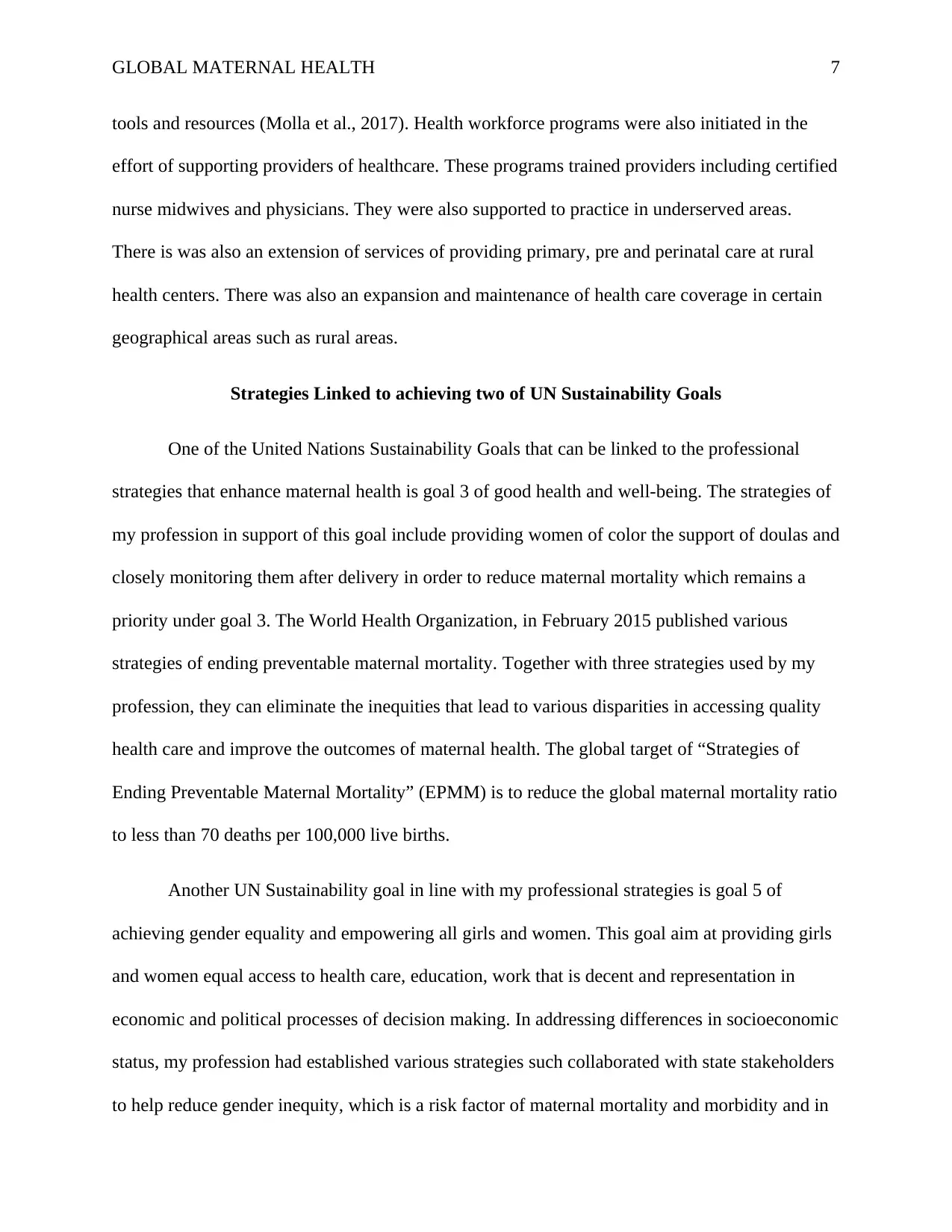
GLOBAL MATERNAL HEALTH 7
tools and resources (Molla et al., 2017). Health workforce programs were also initiated in the
effort of supporting providers of healthcare. These programs trained providers including certified
nurse midwives and physicians. They were also supported to practice in underserved areas.
There is was also an extension of services of providing primary, pre and perinatal care at rural
health centers. There was also an expansion and maintenance of health care coverage in certain
geographical areas such as rural areas.
Strategies Linked to achieving two of UN Sustainability Goals
One of the United Nations Sustainability Goals that can be linked to the professional
strategies that enhance maternal health is goal 3 of good health and well-being. The strategies of
my profession in support of this goal include providing women of color the support of doulas and
closely monitoring them after delivery in order to reduce maternal mortality which remains a
priority under goal 3. The World Health Organization, in February 2015 published various
strategies of ending preventable maternal mortality. Together with three strategies used by my
profession, they can eliminate the inequities that lead to various disparities in accessing quality
health care and improve the outcomes of maternal health. The global target of “Strategies of
Ending Preventable Maternal Mortality” (EPMM) is to reduce the global maternal mortality ratio
to less than 70 deaths per 100,000 live births.
Another UN Sustainability goal in line with my professional strategies is goal 5 of
achieving gender equality and empowering all girls and women. This goal aim at providing girls
and women equal access to health care, education, work that is decent and representation in
economic and political processes of decision making. In addressing differences in socioeconomic
status, my profession had established various strategies such collaborated with state stakeholders
to help reduce gender inequity, which is a risk factor of maternal mortality and morbidity and in
tools and resources (Molla et al., 2017). Health workforce programs were also initiated in the
effort of supporting providers of healthcare. These programs trained providers including certified
nurse midwives and physicians. They were also supported to practice in underserved areas.
There is was also an extension of services of providing primary, pre and perinatal care at rural
health centers. There was also an expansion and maintenance of health care coverage in certain
geographical areas such as rural areas.
Strategies Linked to achieving two of UN Sustainability Goals
One of the United Nations Sustainability Goals that can be linked to the professional
strategies that enhance maternal health is goal 3 of good health and well-being. The strategies of
my profession in support of this goal include providing women of color the support of doulas and
closely monitoring them after delivery in order to reduce maternal mortality which remains a
priority under goal 3. The World Health Organization, in February 2015 published various
strategies of ending preventable maternal mortality. Together with three strategies used by my
profession, they can eliminate the inequities that lead to various disparities in accessing quality
health care and improve the outcomes of maternal health. The global target of “Strategies of
Ending Preventable Maternal Mortality” (EPMM) is to reduce the global maternal mortality ratio
to less than 70 deaths per 100,000 live births.
Another UN Sustainability goal in line with my professional strategies is goal 5 of
achieving gender equality and empowering all girls and women. This goal aim at providing girls
and women equal access to health care, education, work that is decent and representation in
economic and political processes of decision making. In addressing differences in socioeconomic
status, my profession had established various strategies such collaborated with state stakeholders
to help reduce gender inequity, which is a risk factor of maternal mortality and morbidity and in
Paraphrase This Document
Need a fresh take? Get an instant paraphrase of this document with our AI Paraphraser
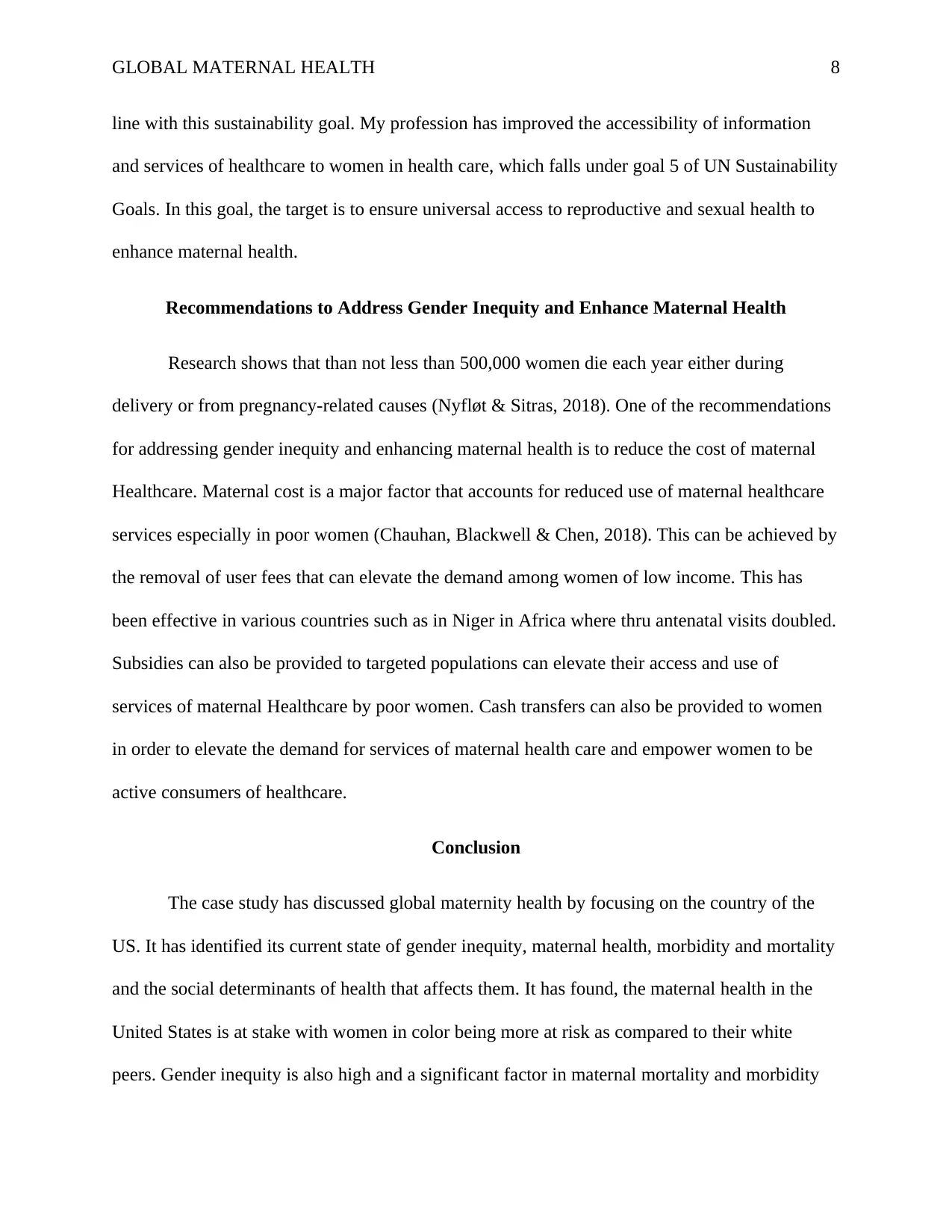
GLOBAL MATERNAL HEALTH 8
line with this sustainability goal. My profession has improved the accessibility of information
and services of healthcare to women in health care, which falls under goal 5 of UN Sustainability
Goals. In this goal, the target is to ensure universal access to reproductive and sexual health to
enhance maternal health.
Recommendations to Address Gender Inequity and Enhance Maternal Health
Research shows that than not less than 500,000 women die each year either during
delivery or from pregnancy-related causes (Nyfløt & Sitras, 2018). One of the recommendations
for addressing gender inequity and enhancing maternal health is to reduce the cost of maternal
Healthcare. Maternal cost is a major factor that accounts for reduced use of maternal healthcare
services especially in poor women (Chauhan, Blackwell & Chen, 2018). This can be achieved by
the removal of user fees that can elevate the demand among women of low income. This has
been effective in various countries such as in Niger in Africa where thru antenatal visits doubled.
Subsidies can also be provided to targeted populations can elevate their access and use of
services of maternal Healthcare by poor women. Cash transfers can also be provided to women
in order to elevate the demand for services of maternal health care and empower women to be
active consumers of healthcare.
Conclusion
The case study has discussed global maternity health by focusing on the country of the
US. It has identified its current state of gender inequity, maternal health, morbidity and mortality
and the social determinants of health that affects them. It has found, the maternal health in the
United States is at stake with women in color being more at risk as compared to their white
peers. Gender inequity is also high and a significant factor in maternal mortality and morbidity
line with this sustainability goal. My profession has improved the accessibility of information
and services of healthcare to women in health care, which falls under goal 5 of UN Sustainability
Goals. In this goal, the target is to ensure universal access to reproductive and sexual health to
enhance maternal health.
Recommendations to Address Gender Inequity and Enhance Maternal Health
Research shows that than not less than 500,000 women die each year either during
delivery or from pregnancy-related causes (Nyfløt & Sitras, 2018). One of the recommendations
for addressing gender inequity and enhancing maternal health is to reduce the cost of maternal
Healthcare. Maternal cost is a major factor that accounts for reduced use of maternal healthcare
services especially in poor women (Chauhan, Blackwell & Chen, 2018). This can be achieved by
the removal of user fees that can elevate the demand among women of low income. This has
been effective in various countries such as in Niger in Africa where thru antenatal visits doubled.
Subsidies can also be provided to targeted populations can elevate their access and use of
services of maternal Healthcare by poor women. Cash transfers can also be provided to women
in order to elevate the demand for services of maternal health care and empower women to be
active consumers of healthcare.
Conclusion
The case study has discussed global maternity health by focusing on the country of the
US. It has identified its current state of gender inequity, maternal health, morbidity and mortality
and the social determinants of health that affects them. It has found, the maternal health in the
United States is at stake with women in color being more at risk as compared to their white
peers. Gender inequity is also high and a significant factor in maternal mortality and morbidity
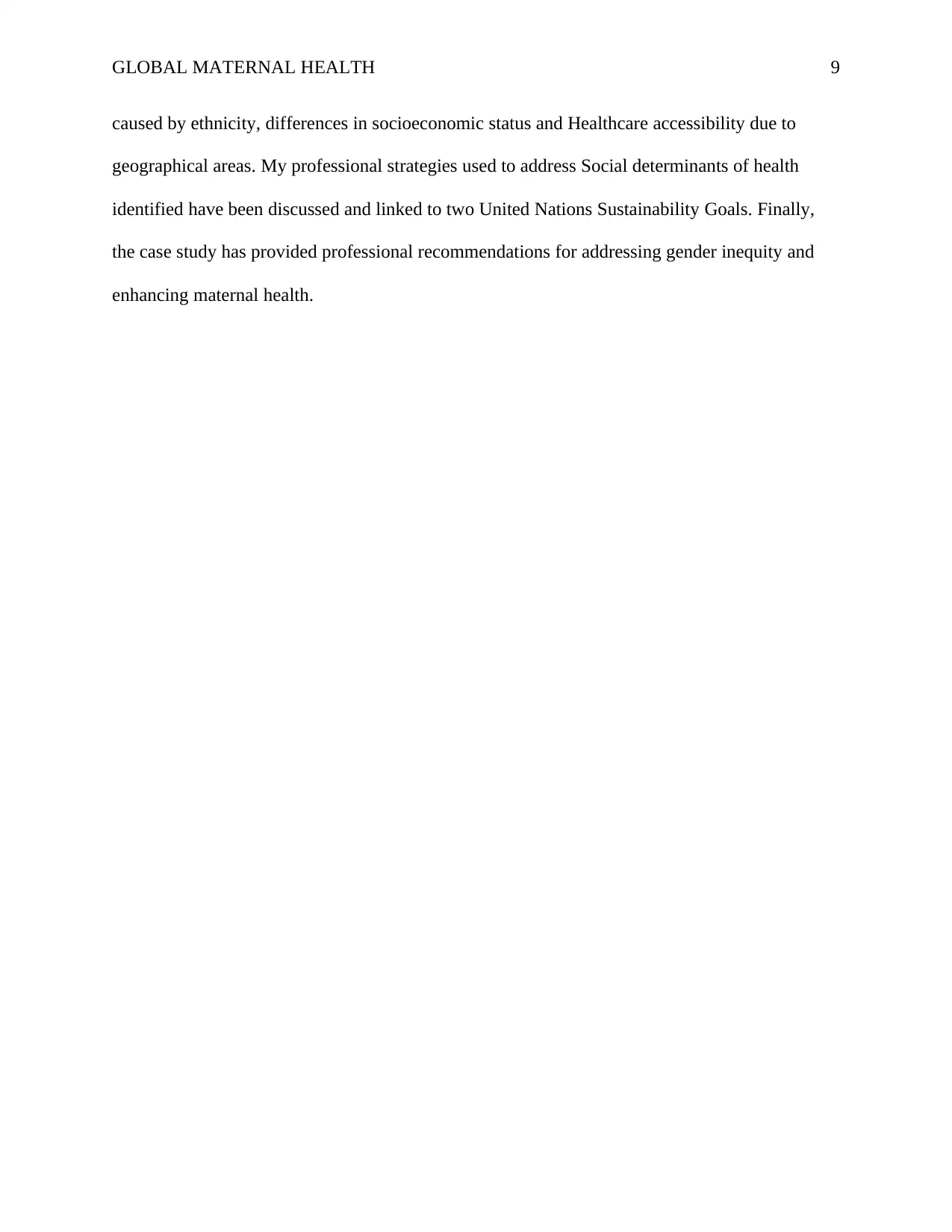
GLOBAL MATERNAL HEALTH 9
caused by ethnicity, differences in socioeconomic status and Healthcare accessibility due to
geographical areas. My professional strategies used to address Social determinants of health
identified have been discussed and linked to two United Nations Sustainability Goals. Finally,
the case study has provided professional recommendations for addressing gender inequity and
enhancing maternal health.
caused by ethnicity, differences in socioeconomic status and Healthcare accessibility due to
geographical areas. My professional strategies used to address Social determinants of health
identified have been discussed and linked to two United Nations Sustainability Goals. Finally,
the case study has provided professional recommendations for addressing gender inequity and
enhancing maternal health.
⊘ This is a preview!⊘
Do you want full access?
Subscribe today to unlock all pages.

Trusted by 1+ million students worldwide
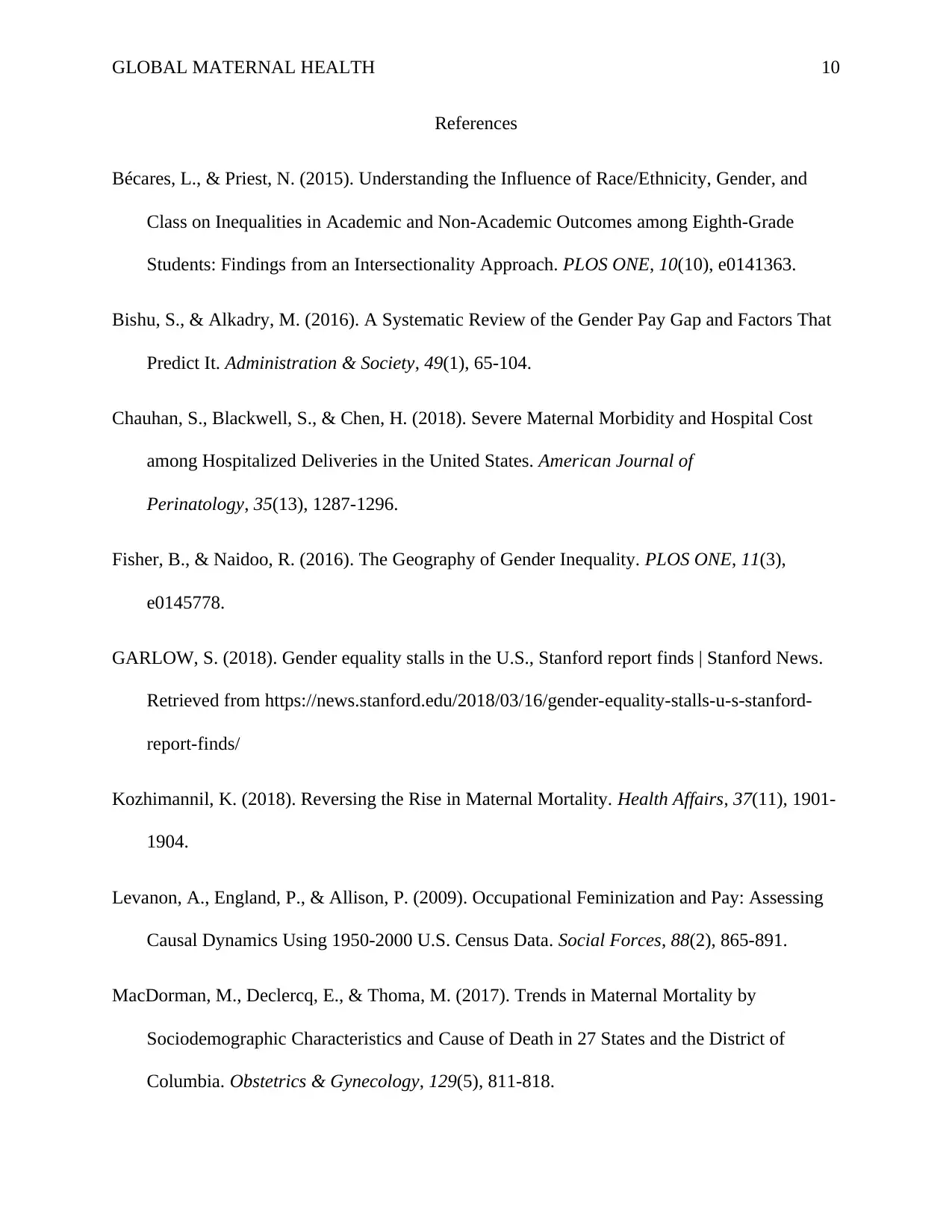
GLOBAL MATERNAL HEALTH 10
References
Bécares, L., & Priest, N. (2015). Understanding the Influence of Race/Ethnicity, Gender, and
Class on Inequalities in Academic and Non-Academic Outcomes among Eighth-Grade
Students: Findings from an Intersectionality Approach. PLOS ONE, 10(10), e0141363.
Bishu, S., & Alkadry, M. (2016). A Systematic Review of the Gender Pay Gap and Factors That
Predict It. Administration & Society, 49(1), 65-104.
Chauhan, S., Blackwell, S., & Chen, H. (2018). Severe Maternal Morbidity and Hospital Cost
among Hospitalized Deliveries in the United States. American Journal of
Perinatology, 35(13), 1287-1296.
Fisher, B., & Naidoo, R. (2016). The Geography of Gender Inequality. PLOS ONE, 11(3),
e0145778.
GARLOW, S. (2018). Gender equality stalls in the U.S., Stanford report finds | Stanford News.
Retrieved from https://news.stanford.edu/2018/03/16/gender-equality-stalls-u-s-stanford-
report-finds/
Kozhimannil, K. (2018). Reversing the Rise in Maternal Mortality. Health Affairs, 37(11), 1901-
1904.
Levanon, A., England, P., & Allison, P. (2009). Occupational Feminization and Pay: Assessing
Causal Dynamics Using 1950-2000 U.S. Census Data. Social Forces, 88(2), 865-891.
MacDorman, M., Declercq, E., & Thoma, M. (2017). Trends in Maternal Mortality by
Sociodemographic Characteristics and Cause of Death in 27 States and the District of
Columbia. Obstetrics & Gynecology, 129(5), 811-818.
References
Bécares, L., & Priest, N. (2015). Understanding the Influence of Race/Ethnicity, Gender, and
Class on Inequalities in Academic and Non-Academic Outcomes among Eighth-Grade
Students: Findings from an Intersectionality Approach. PLOS ONE, 10(10), e0141363.
Bishu, S., & Alkadry, M. (2016). A Systematic Review of the Gender Pay Gap and Factors That
Predict It. Administration & Society, 49(1), 65-104.
Chauhan, S., Blackwell, S., & Chen, H. (2018). Severe Maternal Morbidity and Hospital Cost
among Hospitalized Deliveries in the United States. American Journal of
Perinatology, 35(13), 1287-1296.
Fisher, B., & Naidoo, R. (2016). The Geography of Gender Inequality. PLOS ONE, 11(3),
e0145778.
GARLOW, S. (2018). Gender equality stalls in the U.S., Stanford report finds | Stanford News.
Retrieved from https://news.stanford.edu/2018/03/16/gender-equality-stalls-u-s-stanford-
report-finds/
Kozhimannil, K. (2018). Reversing the Rise in Maternal Mortality. Health Affairs, 37(11), 1901-
1904.
Levanon, A., England, P., & Allison, P. (2009). Occupational Feminization and Pay: Assessing
Causal Dynamics Using 1950-2000 U.S. Census Data. Social Forces, 88(2), 865-891.
MacDorman, M., Declercq, E., & Thoma, M. (2017). Trends in Maternal Mortality by
Sociodemographic Characteristics and Cause of Death in 27 States and the District of
Columbia. Obstetrics & Gynecology, 129(5), 811-818.
Paraphrase This Document
Need a fresh take? Get an instant paraphrase of this document with our AI Paraphraser
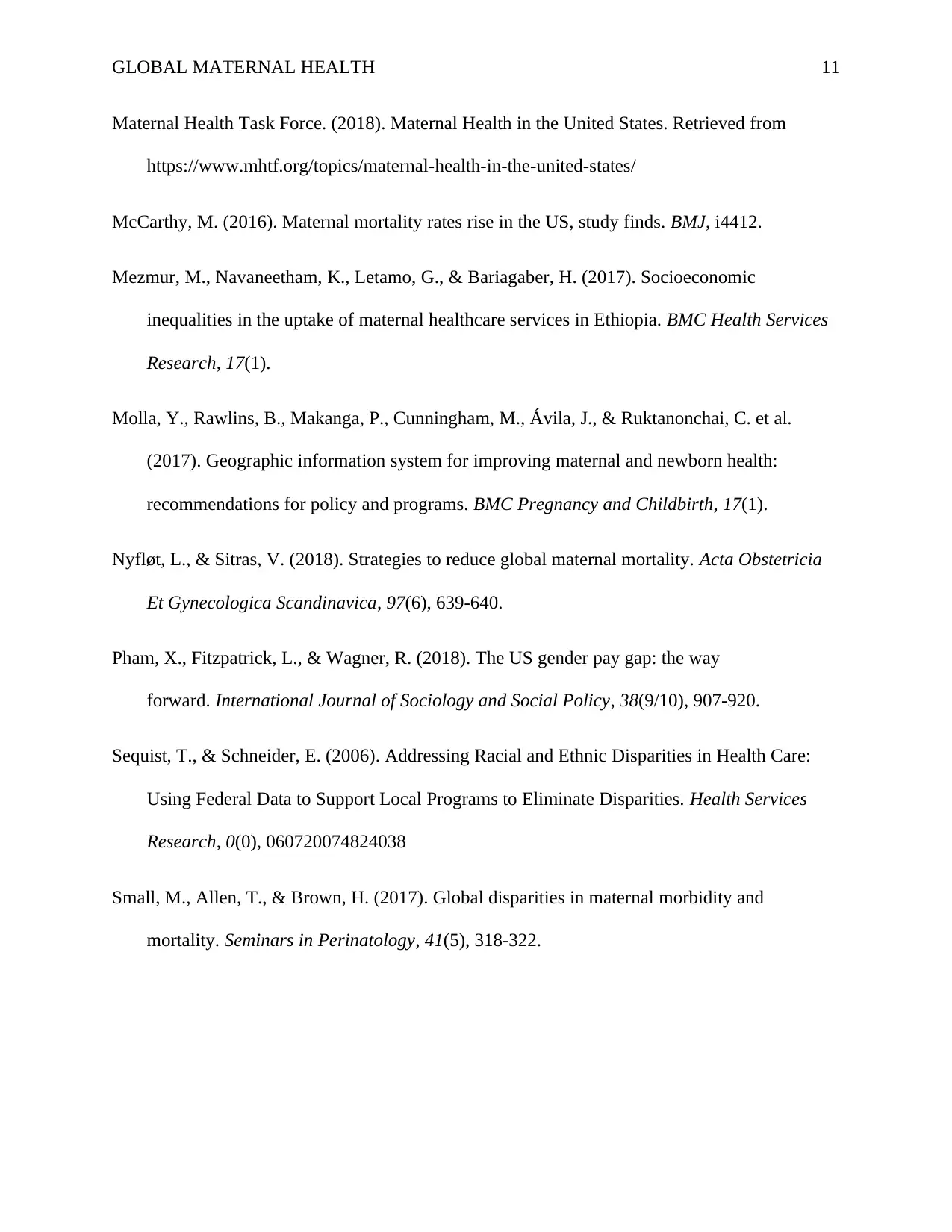
GLOBAL MATERNAL HEALTH 11
Maternal Health Task Force. (2018). Maternal Health in the United States. Retrieved from
https://www.mhtf.org/topics/maternal-health-in-the-united-states/
McCarthy, M. (2016). Maternal mortality rates rise in the US, study finds. BMJ, i4412.
Mezmur, M., Navaneetham, K., Letamo, G., & Bariagaber, H. (2017). Socioeconomic
inequalities in the uptake of maternal healthcare services in Ethiopia. BMC Health Services
Research, 17(1).
Molla, Y., Rawlins, B., Makanga, P., Cunningham, M., Ávila, J., & Ruktanonchai, C. et al.
(2017). Geographic information system for improving maternal and newborn health:
recommendations for policy and programs. BMC Pregnancy and Childbirth, 17(1).
Nyfløt, L., & Sitras, V. (2018). Strategies to reduce global maternal mortality. Acta Obstetricia
Et Gynecologica Scandinavica, 97(6), 639-640.
Pham, X., Fitzpatrick, L., & Wagner, R. (2018). The US gender pay gap: the way
forward. International Journal of Sociology and Social Policy, 38(9/10), 907-920.
Sequist, T., & Schneider, E. (2006). Addressing Racial and Ethnic Disparities in Health Care:
Using Federal Data to Support Local Programs to Eliminate Disparities. Health Services
Research, 0(0), 060720074824038
Small, M., Allen, T., & Brown, H. (2017). Global disparities in maternal morbidity and
mortality. Seminars in Perinatology, 41(5), 318-322.
Maternal Health Task Force. (2018). Maternal Health in the United States. Retrieved from
https://www.mhtf.org/topics/maternal-health-in-the-united-states/
McCarthy, M. (2016). Maternal mortality rates rise in the US, study finds. BMJ, i4412.
Mezmur, M., Navaneetham, K., Letamo, G., & Bariagaber, H. (2017). Socioeconomic
inequalities in the uptake of maternal healthcare services in Ethiopia. BMC Health Services
Research, 17(1).
Molla, Y., Rawlins, B., Makanga, P., Cunningham, M., Ávila, J., & Ruktanonchai, C. et al.
(2017). Geographic information system for improving maternal and newborn health:
recommendations for policy and programs. BMC Pregnancy and Childbirth, 17(1).
Nyfløt, L., & Sitras, V. (2018). Strategies to reduce global maternal mortality. Acta Obstetricia
Et Gynecologica Scandinavica, 97(6), 639-640.
Pham, X., Fitzpatrick, L., & Wagner, R. (2018). The US gender pay gap: the way
forward. International Journal of Sociology and Social Policy, 38(9/10), 907-920.
Sequist, T., & Schneider, E. (2006). Addressing Racial and Ethnic Disparities in Health Care:
Using Federal Data to Support Local Programs to Eliminate Disparities. Health Services
Research, 0(0), 060720074824038
Small, M., Allen, T., & Brown, H. (2017). Global disparities in maternal morbidity and
mortality. Seminars in Perinatology, 41(5), 318-322.
1 out of 11
Related Documents
Your All-in-One AI-Powered Toolkit for Academic Success.
+13062052269
info@desklib.com
Available 24*7 on WhatsApp / Email
![[object Object]](/_next/static/media/star-bottom.7253800d.svg)
Unlock your academic potential
Copyright © 2020–2025 A2Z Services. All Rights Reserved. Developed and managed by ZUCOL.





